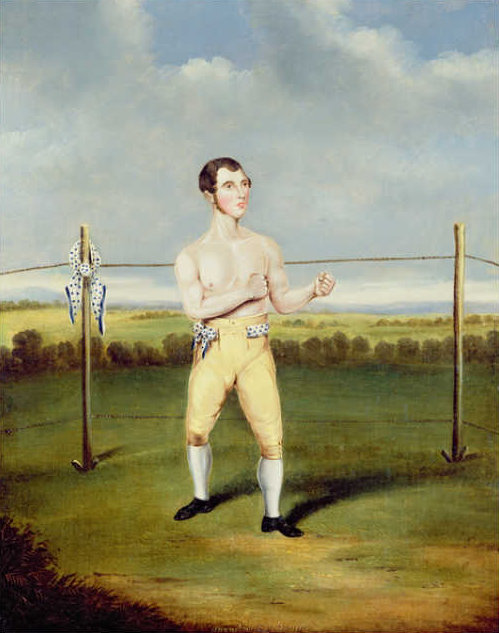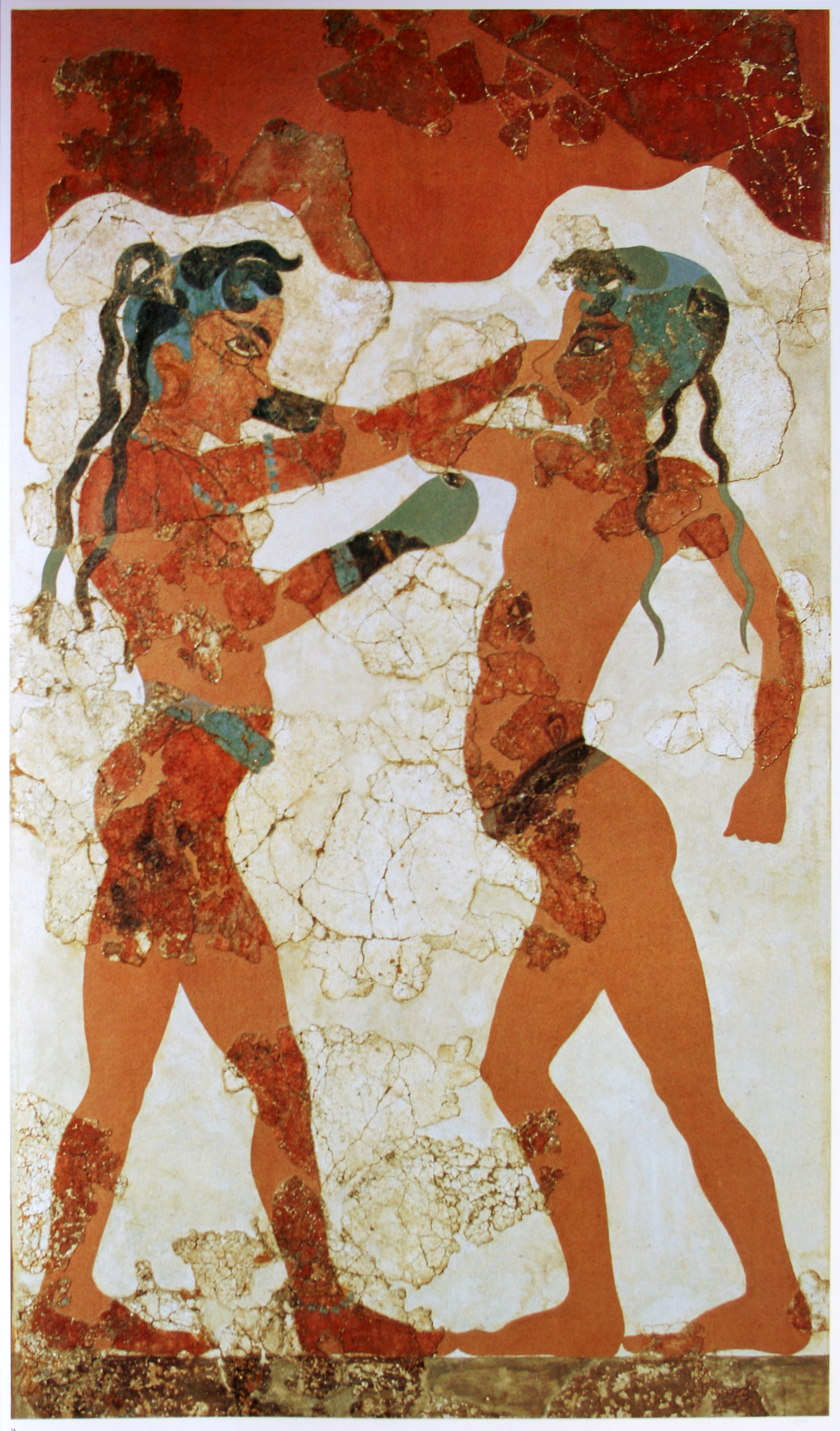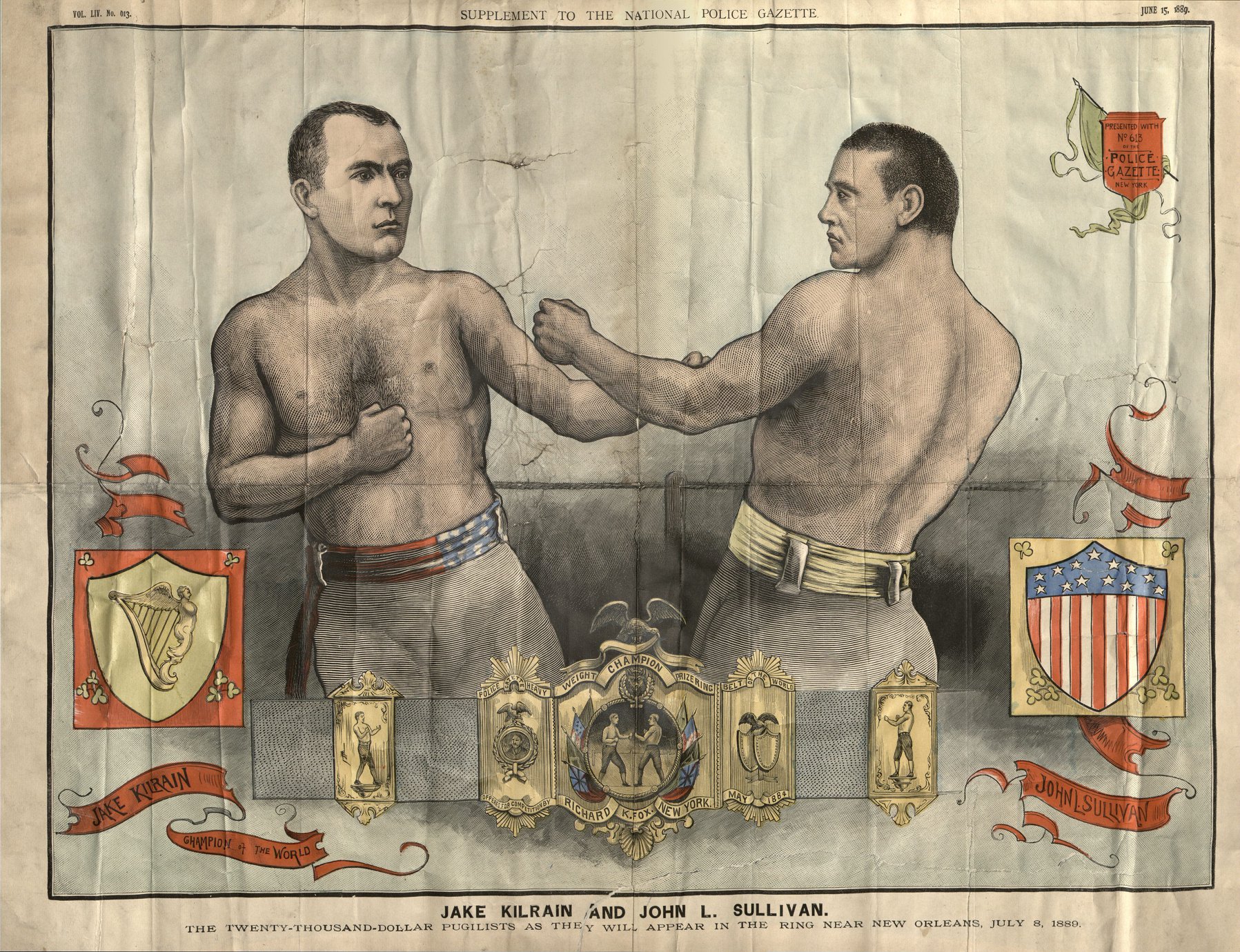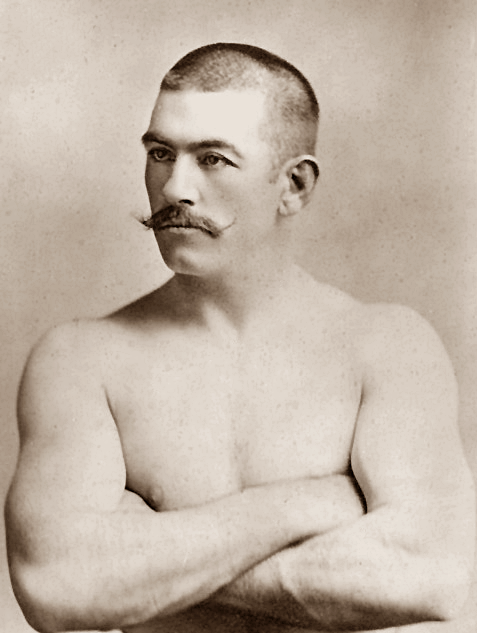|
London Prize Ring Rules
The London Prize Ring Rules were a list of boxing rules promulgated in 1838 and revised in 1853. These rules were based on those drafted by England's Jack Broughton in 1743 (known as the Broughton Rules) and governed the conduct of prizefighting/ bare-knuckle boxing for over 100 years. They "introduced measures that remain in effect for professional boxing to this day, such as outlawing butting, gouging, scratching, kicking, hitting a man while down, holding the ropes, and using resin, stones or hard objects in the hands, and biting." They were later superseded by the Marquess of Queensberry Rules, which were the origin of the modern sport of boxing. Scope Fights under these rules were often contested with bare knuckles. The rules also allowed for a broad range of fighting including holds and throws of the opponent. Spiked shoes, within limits, were also allowed. Also included were provisions dealing with how wagers would be resolved if various events such as interferen ... [...More Info...] [...Related Items...] OR: [Wikipedia] [Google] [Baidu] |
Jack Broughton
John "Jack" Broughton (c. 1703 – 8 January 1789) was an English bare-knuckle boxer. He was the first person to codify a set of rules to be used in such contests; prior to this the "rules" that existed were very loosely defined and tended to vary from contest to contest. His seven rules of how boxing would be conducted at his amphitheatre were widely used in boxing for nearly century, until they were replaced by the London Prize Ring rules in 1838. Early life Little is certain about John Broughton's early life. He was born to unknown parents, possibly in London, though one early-20th-century history of boxing claims that he was a farmer's son from Baunton, Gloucestershire. Apprentice records show that Broughton was apprenticed to a Thames waterman in May 1723. On 1 August 1730, Broughton won the annual Doggett's Coat and Badge rowing race among watermen who had completed their apprenticeship within the previous year. At the time, he was noted as working on the shore near H ... [...More Info...] [...Related Items...] OR: [Wikipedia] [Google] [Baidu] |
Owen Swift
Owen Swift (1814– 9 June 1879) was a British bare-knuckle prize fighter, who killed three men in boxing bouts. The death of "Brighton Bill" in one particularly savage 85-round bout in 1838, and Swift's subsequent conviction for manslaughter, led to the adoption of the London Prize Ring Rules. Career His 1 June 1837 fight with Israel "London Izzy" Lazarus (the father of Harry Lazarus) is recounted in detail in Frank Lewis Dowling's 1855 book, ''Fights for the Championship; and Celebrated Prize Battles; Or Accounts of All the Prize Battles for the Championship &c.'' Swift was the outsider, and at odds of 6 to 4, bet on himself to win. Swift was much the lighter man, at no more than nine stone (57 kg; 130 lb) in weight, with "not an ounce of superfluous flesh on his ribs". The odds on both fighters changed many times, and each was "within an ace of losing". The fight lasted 113 rounds, two hours and fifteen minutes, and Lazarus was "dreadfully punished", and it was hi ... [...More Info...] [...Related Items...] OR: [Wikipedia] [Google] [Baidu] |
1838 In Sports
1838 in sports describes the year's events in world sport. Boxing Events * 3 April — in his return fight with Ben Caunt, William "Bendigo" Thompson is disqualified in the 75th round for going down without being struck. * Caunt claims the English Championship after defeating Bendigo but is not recognised because of the prior claim of James Burke, who has now returned to England from America; meanwhile, Jem Ward continues his refusal to formally surrender the title even though he has long retired.Cyber Boxing Zone – James Burke Retrieved on 7 November 2009. * Publication of the of 1838 which succeed and are built upon the Broughton Rules of 174 ... [...More Info...] [...Related Items...] OR: [Wikipedia] [Google] [Baidu] |
1838 Establishments In England
Events January–March * January 10 – A fire destroys Lloyd's Coffee House and the Royal Exchange in London. * January 11 – At Morristown, New Jersey, Samuel Morse, Alfred Vail and Leonard Gale give the first public demonstration of Morse's new invention, the telegraph. * January 11 - A 7.5 earthquake strikes the Romanian district of Vrancea causing damage in Moldavia and Wallachia, killing 73 people. * January 21 – The first known report about the lowest temperature on Earth is made, indicating in Yakutsk. * February 6 – Boer explorer Piet Retief and 60 of his men are massacred by King Dingane kaSenzangakhona of the Zulu people, after Retief accepts an invitation to celebrate the signing of a treaty, and his men willingly disarm as a show of good faith. * February 17 – Weenen massacre: Zulu impis massacre about 532 Voortrekkers, Khoikhoi and Basuto around the site of Weenen in South Africa. * February 24 – U.S. Representatives William J. Graves of ... [...More Info...] [...Related Items...] OR: [Wikipedia] [Google] [Baidu] |
Boxing Rules And Regulations
Boxing (also known as "Western boxing" or "pugilism") is a combat sport in which two people, usually wearing protective gloves and other protective equipment such as hand wraps and mouthguards, throw punches at each other for a predetermined amount of time in a boxing ring. Although the term "boxing" is commonly attributed to "western boxing", in which only the fists are involved, boxing has developed in various ways in different geographical areas and cultures. In global terms, boxing is a set of combat sports focused on striking, in which two opponents face each other in a fight using at least their fists, and possibly involving other actions such as kicks, elbow strikes, knee strikes, and headbutts, depending on the rules. Some of the forms of the modern sport are western boxing, bare knuckle boxing, kickboxing, muay-thai, lethwei, savate, and sanda. Boxing techniques have been incorporated into many martial arts, military systems, and other combat sports. While huma ... [...More Info...] [...Related Items...] OR: [Wikipedia] [Google] [Baidu] |
Jake Kilrain
John Joseph Killion (February 9, 1859 – December 22, 1937), more commonly known as Jake Kilrain, was a famous American bare-knuckle fighter and glove boxer of the 1880s. Early life Kilrain found employment as a teenager in Somerville, Massachusetts. As a country boy from Long Island, he had to learn how to stand up to the workers in the rolling mills. By the age of 20, he had been recognized as the toughest fighter in the mill. Kilrain was also a champion rower having won the National Amateur Junior Sculling Championship in 1883. He was later stripped of that honor when it was discovered that he was a prizefighter and thus could not be considered an amateur. In 1883, Kilrain took up prizefighting as a profession and quickly established a reputation as a very tough fighter. Professional career World Championship fight with Jem Smith By 1887 Kilrain already has been recognized as the U.S. National Champion, that gave him an opportunity to fight for the Championship of ... [...More Info...] [...Related Items...] OR: [Wikipedia] [Google] [Baidu] |
Paddy Ryan
Patrick Ryan (15 March 1851 – 14 December 1900) was an Irish American boxer, and became the bare-knuckle American heavyweight champion on May 30, 1880, after he won the title from Joe Goss. He retained the title until losing it to the exceptional John L. Sullivan on February 7, 1882. Ryan fought only ten major bouts, but as many as twenty-five exhibitions including many Sullivan in his late career. Exhibitions brought him income, but with fewer rounds and less risk. Early life and career Ryan was born in Thurles, Tipperary, Ireland on March 14, 1851. After moving to America, he lived in the Troy, New York area and was consequently nicknamed the "Trojan Giant". He may have apprenticed as a blacksmith in an early career, but was definitely working in the profession by the time he lived in Troy. As a stout youth, Ryan worked on the construction of the Erie Canal before pursuing his boxing career. After opening a Troy saloon in 1874, he caught the attention of the athletic ... [...More Info...] [...Related Items...] OR: [Wikipedia] [Google] [Baidu] |
John L
John Lasarus Williams (29 October 1924 – 15 June 2004), known as John L, was a Welsh nationalist activist. Williams was born in Llangoed on Anglesey, but lived most of his life in nearby Llanfairpwllgwyngyll. In his youth, he was a keen footballer, and he also worked as a teacher. His activism started when he campaigned against the refusal of Brewer Spinks, an employer in Blaenau Ffestiniog, to permit his staff to speak Welsh. This inspired him to become a founder of Undeb y Gymraeg Fyw, and through this organisation was the main organiser of ''Sioe Gymraeg y Borth'' (the Welsh show for Menai Bridge using the colloquial form of its Welsh name).Colli John L Williams , '''', ... [...More Info...] [...Related Items...] OR: [Wikipedia] [Google] [Baidu] |
Jem Mace
James "Jem" Mace (8 April 1831 – 30 November 1910) was an English boxing champion, primarily during the bare-knuckle era. He was born at Beeston, Norfolk. Although nicknamed "The Gypsy", he denied Romani ethnicity in his autobiography. Fighting in England, at the height of his career between 1860 and 1866, he won the English Welterweight, Heavyweight, and Middleweight Championships and was considered one of the most scientific boxers of the era. Most impressively, he held the World Heavyweight Championship from 1870 to 1871 while fighting in the United States.Roberts, James, and Skutt, Alexander,''Boxing Register'', (2006) International Boxing Hall of Fame, McBooks Press, Ithaca, New York, pg. 35 Boxing career Mace was born the fifth of eight children to blacksmith William and his wife Ann Rudd Mace on 8 April 1831, in the remote village of Beeston, in rural Norfolk, England. In the early 1850s, during his days as an exhibition boxer at Nat Langham's Rum Pum-pas boxing ... [...More Info...] [...Related Items...] OR: [Wikipedia] [Google] [Baidu] |
Joe Goss
Joseph Goss was an English bare knuckle boxer. After defeating Tom Allen in Boone County, Kentucky, he held the American and what many boxing historians now consider the World Heavyweight boxing championship from 7 September 1876 to 30 May 1880. Although he rarely scaled more than 160 pounds, the clever and aggressive Goss routinely fought men both bigger and heavier than himself.Roberts, James, and Skutt, Alexander,''Boxing Register'', (2006) International Boxing Hall of Fame, McBooks Press, Ithaca, New York, pg. 29 Early life and career Goss was born on 6 November 1837 in Northampton, Northamptonshire, East Midlands, England. His father was a shoemaker, and brought his son up in that trade. By 18, Goss was fighting exhibitions at county fairs and beginning to win a reputation as a talented hard hitting boxer. At the age of twenty, Goss began his career with a 90-minute victory over George Ayers at London's Brompton Bushes for the modest sum of £5. Goss then defeated Jac ... [...More Info...] [...Related Items...] OR: [Wikipedia] [Google] [Baidu] |
Tom Sayers
Tom Sayers (15 or 25 May 18268 November 1865) was an English bare-knuckle prize fighter. There were no formal weight divisions at the time, and although Sayers was only five feet eight inches tall and never weighed much more than 150 pounds, he frequently fought much bigger men. In a career which lasted from 1849 until 1860, he lost only one of sixteen bouts. He was recognized as heavyweight champion of England between 1857, when he defeated William Perry (the "Tipton Slasher") and his retirement in 1860. His lasting fame depended exclusively on his final contest, when he faced American champion John Camel Heenan in a battle which was widely considered to be boxing's first world championship. It ended in chaos when the spectators invaded the ring, and the referee finally declared a draw. Regarded as a national hero, Sayers, for whom the considerable sum of £3,000 was raised by public subscription, then retired from the ring. After his death five years later at the age of 39 ... [...More Info...] [...Related Items...] OR: [Wikipedia] [Google] [Baidu] |






.jpg)

